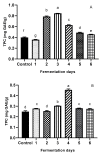Solid-State Yeast Fermented Wheat and Oat Bran as A Route for Delivery of Antioxidants
- PMID: 31487918
- PMCID: PMC6770529
- DOI: 10.3390/antiox8090372
Solid-State Yeast Fermented Wheat and Oat Bran as A Route for Delivery of Antioxidants
Abstract
The purpose of our study was to evaluate the potential of solid-state yeast fermentation (SSYF) in improving the phenolic acid content and composition, and the antioxidant activity of commercial wheat bran (WB) and oat bran (OB). The ultrasound-assisted methanolic extracts were compared for their total phenolic content (TPC), phenolics composition, and in vitro antioxidant activity in order to study the effect of fermentation time on the chemical profile and activity of bioactive compounds. The comparative analysis revealed significant differences (p < 0.05) between days of fermentation (0 through 6). The highest TPCs were obtained on day 3 for WB (0.84 ± 0.05 mg of gallic acid equivalents [GAE]/g dry weight [DW]), and on day 4 for OB (0.45 ± 0.02 mg GAE/g DW). The highest relative percentage increase in the phenolics concentration of WB was also registered on day 3 (ferulic acid +56.6%, vanillic acid +259.3%, dihydroxybenzoic acids +161.2%, apigenin-glucoside +15.3%); for OB, this was observed on day 4 (avenanthramide 2f +48.5%, ferulic acid +21.2%). Enhanced antioxidant activities were significantly correlated with the highest TPCs. Our results suggest that SSYF may be a useful procedure for enrichment of antioxidants in cereal bran, considering the design of different functional foods and nutraceuticals.
Keywords: antioxidants enrichment; bioprocess; enzymes; low cost; oat bran; phenolic acids; solid-state fermentation; sustainability; wheat bran; yeast.
Conflict of interest statement
The authors declare no conflict of interest.
Figures





Similar articles
-
Thermal Processing for the Release of Phenolic Compounds from Wheat and Oat Bran.Biomolecules. 2019 Dec 22;10(1):21. doi: 10.3390/biom10010021. Biomolecules. 2019. PMID: 31877857 Free PMC article.
-
Integration of ultrasound and microwave pretreatments with solid-state fermentation enhances the release of sugars, organic acids, and phenolic compounds in wheat bran.Food Chem. 2025 Jan 15;463(Pt 3):141237. doi: 10.1016/j.foodchem.2024.141237. Epub 2024 Sep 16. Food Chem. 2025. PMID: 39305639
-
Enhancing phenolic and lipid compound production in oat bran via acid pretreatment and solid-state fermentation with Aspergillus niger.N Biotechnol. 2024 Nov 25;83:91-100. doi: 10.1016/j.nbt.2024.07.003. Epub 2024 Jul 23. N Biotechnol. 2024. PMID: 39053684
-
Evaluation of antioxidant capacity of cereal brans.J Agric Food Chem. 2004 Jul 28;52(15):4690-9. doi: 10.1021/jf049621s. J Agric Food Chem. 2004. PMID: 15264901
-
Integrated Technology for Cereal Bran Valorization: Perspectives for a Sustainable Industrial Approach.Antioxidants (Basel). 2022 Oct 31;11(11):2159. doi: 10.3390/antiox11112159. Antioxidants (Basel). 2022. PMID: 36358531 Free PMC article. Review.
Cited by
-
Awareness, Knowledge, and Interest about Prebiotics-A Study among Romanian Consumers.Int J Environ Res Public Health. 2022 Jan 21;19(3):1208. doi: 10.3390/ijerph19031208. Int J Environ Res Public Health. 2022. PMID: 35162231 Free PMC article.
-
Recent Advances in Biotechnological Itaconic Acid Production, and Application for a Sustainable Approach.Polymers (Basel). 2021 Oct 16;13(20):3574. doi: 10.3390/polym13203574. Polymers (Basel). 2021. PMID: 34685333 Free PMC article. Review.
-
Mathematical Modeling and Optimization of Lactobacillus Species Single and Co-Culture Fermentation Processes in Wheat and Soy Dough Mixtures.Front Bioeng Biotechnol. 2022 Jun 23;10:888827. doi: 10.3389/fbioe.2022.888827. eCollection 2022. Front Bioeng Biotechnol. 2022. PMID: 35814014 Free PMC article.
-
Recent Developments in Fermented Cereals on Nutritional Constituents and Potential Health Benefits.Foods. 2022 Jul 27;11(15):2243. doi: 10.3390/foods11152243. Foods. 2022. PMID: 35954011 Free PMC article. Review.
-
Solid-State Fermentation as Green Technology to Improve the Use of Plant Feedstuffs as Ingredients in Diets for European Sea Bass (Dicentrarchus labrax) Juveniles.Animals (Basel). 2023 Aug 23;13(17):2692. doi: 10.3390/ani13172692. Animals (Basel). 2023. PMID: 37684956 Free PMC article.
References
-
- FAOSTAT. [(accessed on 18 July 2019)]; Available online: http://www.fao.org/faostat/en/#data/QC.
-
- Peterson D.M., Hahn M.J., Emmons C.L. Oat avenanthramides exhibit antioxidant activities in vitro. Food Chem. 2002;79:473–478. doi: 10.1016/S0308-8146(02)00219-4. - DOI
-
- Kim K., Tsao R., Yang R., Cui S. Phenolic acid profiles and antioxidant activities of wheat bran extracts and the effect of hydrolysis conditions. Food Chem. 2006;95:466–473. doi: 10.1016/j.foodchem.2005.01.032. - DOI
-
- Zhang L., Gao W., Chen X., Wang H. The Effect of bioprocessing on the phenolic acid composition and antioxidant activity of wheat bran. Cereal Chem. 2014;91:255–261. doi: 10.1094/CCHEM-03-13-0056-R. - DOI
-
- Dey T.B., Chakraborty S., Jain K.K., Sharma A., Kuhad R.C. Antioxidant phenolics and their microbial production by submerged and solid state fermentation process: A review. Trends Food Sci. Technol. 2016;53:60–74.
Grants and funding
LinkOut - more resources
Full Text Sources
Other Literature Sources
Miscellaneous

